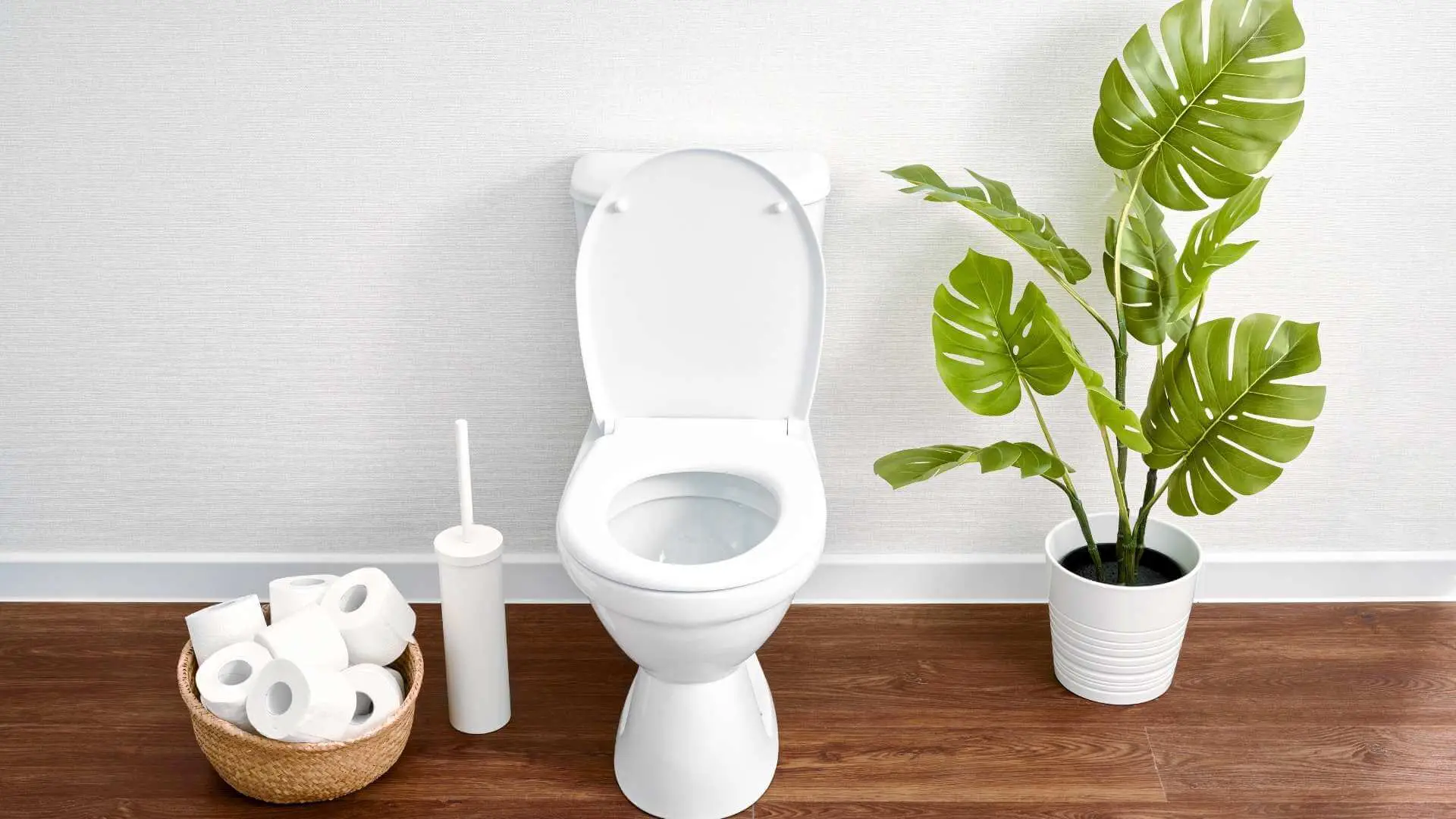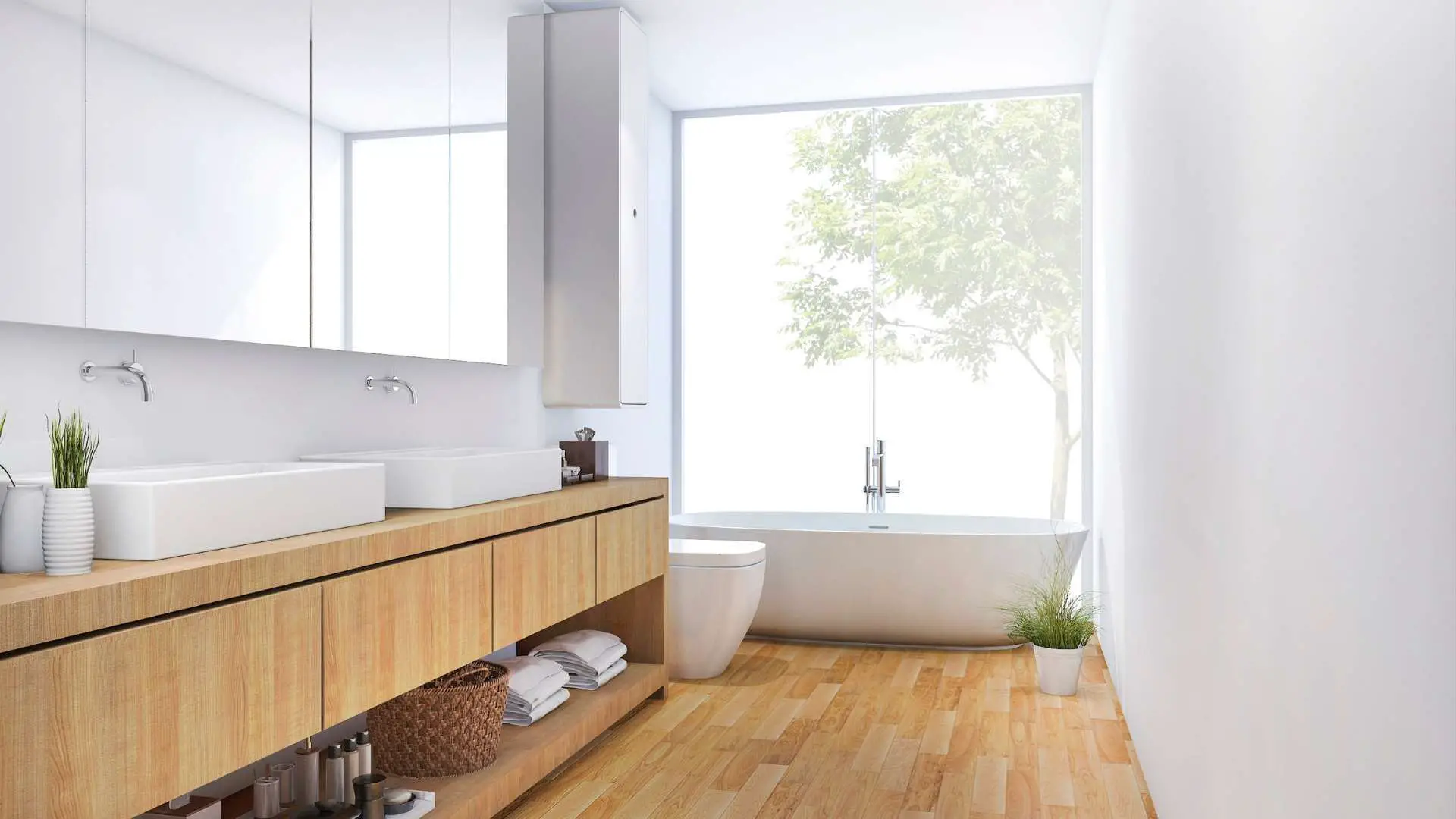Hardwoods are also an excellent choice for toilet floorings, but how do you protect them from constant water?
Because of its everyday use, Toilet floors are constantly exposed to moisture which can lead to wood damage, and there is a wide range of attractive toilet wood options with specific treatments to reduce water damage.
To protect wood floors around toilet, there are options like using wood sealants and oil to act as a barrier to protect the wood from water damage.
Sealing agents like varnish, polyurethane, and lacquer can be used to protect the floorings, and they can also be reapplied monthly to help your floors last longer.
Related: Can You Use Fabuloso On Wood Floor
How to Protect Wood Floors Around Toilet
Table of Contents
A toilet is a place we continually use water; it requires special and extra care. so these are ways to protect the wood in the toilet.
1. Fix Issue at Once
Are you having any leakage in the toilet? Leakage from sinks and pipes should be taken seriously because letting water sit or pool up on woods can damage it.
2. Spot Clean
This oil, lemon, and vinegar are a great way to spot pristine woods. Mix oil and lemon vinegar into a sprayer, spray on the stained wood, and wipe to get rid of it.
The mixture of oil and lemon/ vinegar is one of the most wood-preserving liquids out there, and it has a good smell.
3. Make Use of Mats and Rugs
Consider investing in thicker bath mats and rugs. This soaks up water when you step out of the bathtub and prevents spreading water to other parts.
4. Waterproof Consistently
You should waterproof at least yearly. This goes a long way in preventing water damage.
5. Use of Humidifier or Ceiling Fans
This dries up moisture in the toilet space thereby reducing the possible growth of molds.
Wood Floor and Toilet Waterproofing
Hardwood like classic teaks, dark oak, and walnuts are the better choice for bathroom floorings, and this is due to their high density, which makes them less susceptible to warpage.
Waterproofing is measures taken to prevent water seepage from the floor and walls.
Reasons to Waterproof Toilets
- Water damage: water can cause damage to your toilet floors, wall paints, and furniture decays. The best way to minimize this damage to the toilet is to waterproof the woods around it.
- Infestation: a whole lot of bacteria and pests thrive in damp environments. Keeping your toilets wet is not healthy as it can lead to infection.
- Structural damage: over time, the buildup of the moisture trapped in floors can weaken the subfloors, leading to structural damage. This is very common in toilets with poor ventilation.
- Low maintenance cost: waterproofing helps prevent moisture from getting trapped in walls, which can lead to the longevity of floors, thereby saving owners a massive amount of money from constant repairs.
- Maintain property value: the value of your home is being maintained or improved if you keep it in good shape and condition.
Below are ways you can use to waterproof woods around your toilet
Waterproofing With Oil: Tung Oil and Linseed Oil
Tung oil and linseed oil as waterproof have been used for centuries; it is absorbed into the wood and act as a barrier for water to get through.
Here is how to waterproof with oil:
- Mix and Stir together
- Use a natural bristle brush paintbrush to apply the mixture to the woods
- Allow the oil to absorb into the surface before you reapply to the area that might seem dry
- Use dry cloths to wipe any excess oil
- Allow for thorough drying, depending on the use of oil in the mixture; this can last for a few hours to overnight
- Softly sand the surface with a fine-grit sandpaper
Waterproofing Wood With Wood Sealer
Sealants like varnish, polyurethane, and lacquer are brushed or sprayed onto sanded wood and allowed to dry completely before being lightly re-sanded and recoated.
Avoid the shaking of sealants before applying because it leads to bubbles on the surface of the wood. They provide excellent waterproofing, and they quickly get dry.
Polyurethane Wood Sealants
This gives you the neatest and smoothest surface you can get. Most polyurethane contain oil. It is long-lasting and provides high gloss.
Varnish
Varnish is recommended for use in places that are prone to moisture.
Lacquer
Lacquer is the strongest of all three; it’s resistant to moisture and scratch is outstanding, tends to get yellow over time, and is more suitable for darker woods.
Read: Best Commercial Steam Cleaner
Steps to Waterproof with Sealants
- Choose and prepare a sealer
- Using a paintbrush, apply the sealant to the wood surface
- Let it dry
- Clean with a soft grit 320 paper
- Clean with a damp cloth to get rid of residues behind
- Reapply a second coat
- Let it dry
Always read up on the manufacturer’s instructions to get the best result from your sealants. It tells you how much time you need to wait for the drying process.
Waterproofing with Resin and Acetone
- Waterproofing with resin and acetone gives you one of the most robust results out there and can last up to 5 years. It dries fast, and there is no need to sand the wood.
- Get the right products and mix.
- Apply using a soft-bristled paintbrush
- Let it dry
- Reapply the mixture again and let it cure
Waterproof with Stain and Varnish
Varnish is a waterproof coat that forms a protective layer when applied to woods. There are different types of varnish available, choose the one suitable to your needs to get the best result.
Steps to Waterproof with Stain and Varnish
- Prepare the mixture
- Apply the first coat
- Remove excess with a dry clothe
- Reapply the second coat
Let it dry
Frequently Asked Questions: How to Protect Wood Floors Around Toilet
Are Wood Floors Ok in Bathrooms?
Wood floors are perfectly okay to use in the bathroom; it only requires extra care and maintenance.
Woods like teak is a good flooring choice for the bathroom because of its strong moisture resistance.
Can You Waterproof Wood Floors?
There are various ways you can waterproof wood floors, ranging from Tung oil, polyurethane, lacquer, and others.
Read: How to Get Rid of Tiny Black Dots on Wood Floor
Conclusions
The health benefit of protecting wood floors around toilets cannot be overemphasized. When properly maintained, wood floors around the toilet can last longer.
This article was written to help you understand every detail about how to protect wood floors around toilets and to help you make an informed decision when faced with the choice.
We hope you found it helpful; if you did, kindly share it across your entire social media pages.

